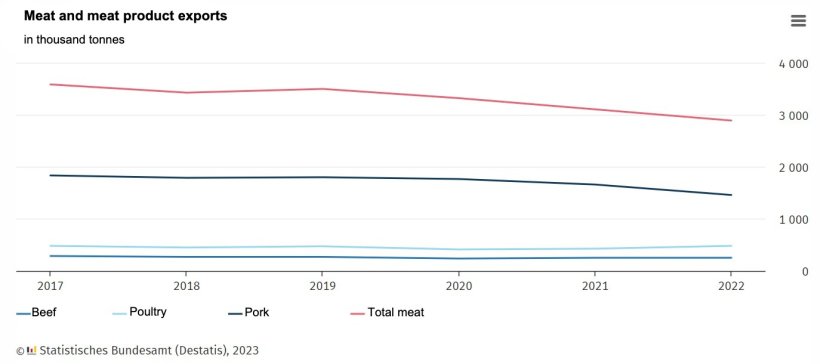According to data from the Federal Statistical Office (Destatis), in 2022 Germany exported almost 2.9 million tons of meat and meat products, mostly to other European Union (EU) countries. This represents a drop of 6.9% compared to the previous year. Over the past five years, meat exports have fallen by 19.3%. In 2017, Germany exported almost 3.6 million t of meat.
By category, 1.5 million t of pork was exported in 2022 (50.5% of total exports), down 20.4% over the past five years. Beef exports fell by 11.4% to 254,000 t, but exports of poultry meat remained relatively constant (-0.2%), at about 481,500 t.

Import restrictions in consumer countries such as China are likely one of the reasons for the decrease in meat exports. While 9.7% of all meat exports went to China in 2017, this figure was only 0.1% in 2022.

Evolution of meat and meat product exports in Germany. Source: Destatis.
Meat imports fall 16% over the last five years
A similar trend can be observed in meat imports: in 2022, Germany imported 2 million t of meat, mainly from other EU countries, which represents a 4.5% decrease compared to the previous year. Over the past five years, meat imports have fallen by 15.9%. In 2017, Germany imported 2.4 million t of meat.
By category, there is also a clear drop in the amount of imported pork: it fell by almost a quarter (-23.4%) from 2017 to 2022. In 2022, around 701,400 t of pork was imported. Beef imports fell by 12% to just under 324,200 t, and poultry imports fell less sharply (-5.2%) to 657,600 t.
Above-average prices for meat and meat products
Like many other food prices, meat prices also rose above average last year. In 2022, German consumers paid 14.5% more for meat and meat products compared to the year prior. Poultry meat was the most expensive (+22.9%), followed by beef (+19.2%) and pork (+16.7%).
March 17, 2023/ Destatis/ Germany.
https://www.destatis.de





